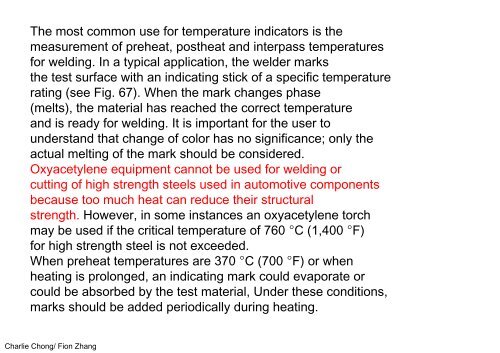ASNT Level III- Visual & Optical Testing
My Level III Self Study Notes Reading 4 Section 4B
My Level III Self Study Notes Reading 4 Section 4B
You also want an ePaper? Increase the reach of your titles
YUMPU automatically turns print PDFs into web optimized ePapers that Google loves.
The most common use for temperature indicators is the<br />
measurement of preheat, postheat and interpass temperatures<br />
for welding. In a typical application, the welder marks<br />
the test surface with an indicating stick of a specific temperature<br />
rating (see Fig. 67). When the mark changes phase<br />
(melts), the material has reached the correct temperature<br />
and is ready for welding. It is important for the user to<br />
understand that change of color has no significance; only the<br />
actual melting of the mark should be considered.<br />
Oxyacetylene equipment cannot be used for welding or<br />
cutting of high strength steels used in automotive components<br />
because too much heat can reduce their structural<br />
strength. However, in some instances an oxyacetylene torch<br />
may be used if the critical temperature of 760 °C (1,400 °F)<br />
for high strength steel is not exceeded.<br />
When preheat temperatures are 370 °C (700 °F) or when<br />
heating is prolonged, an indicating mark could evaporate or<br />
could be absorbed by the test material, Under these conditions,<br />
marks should be added periodically during heating.<br />
Charlie Chong/ Fion Zhang


















